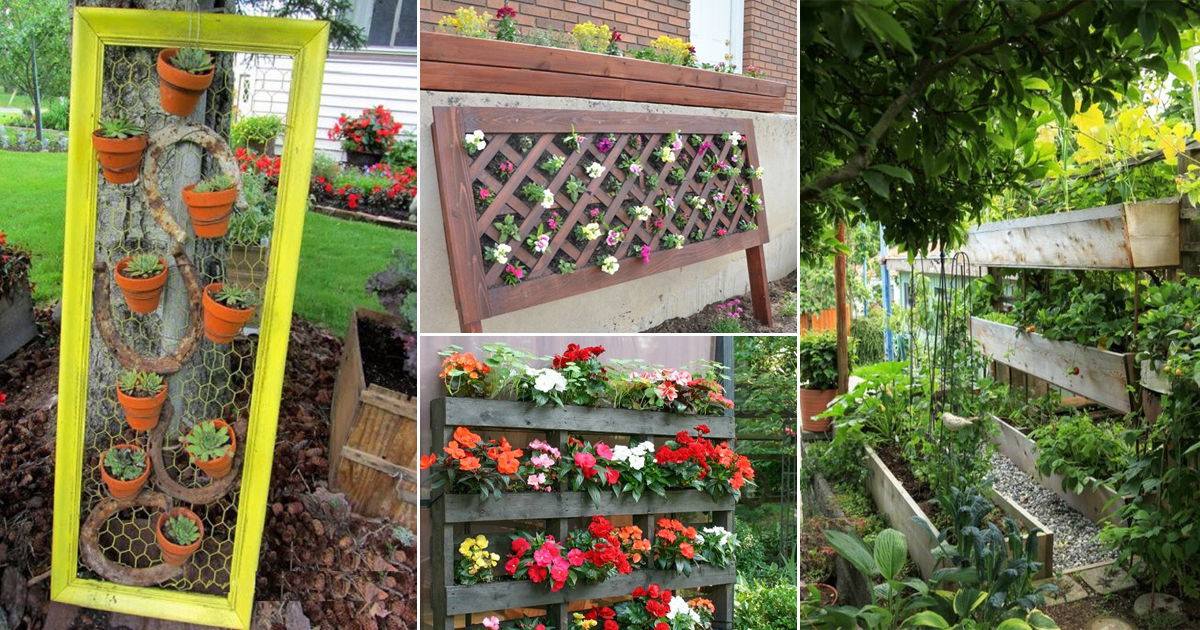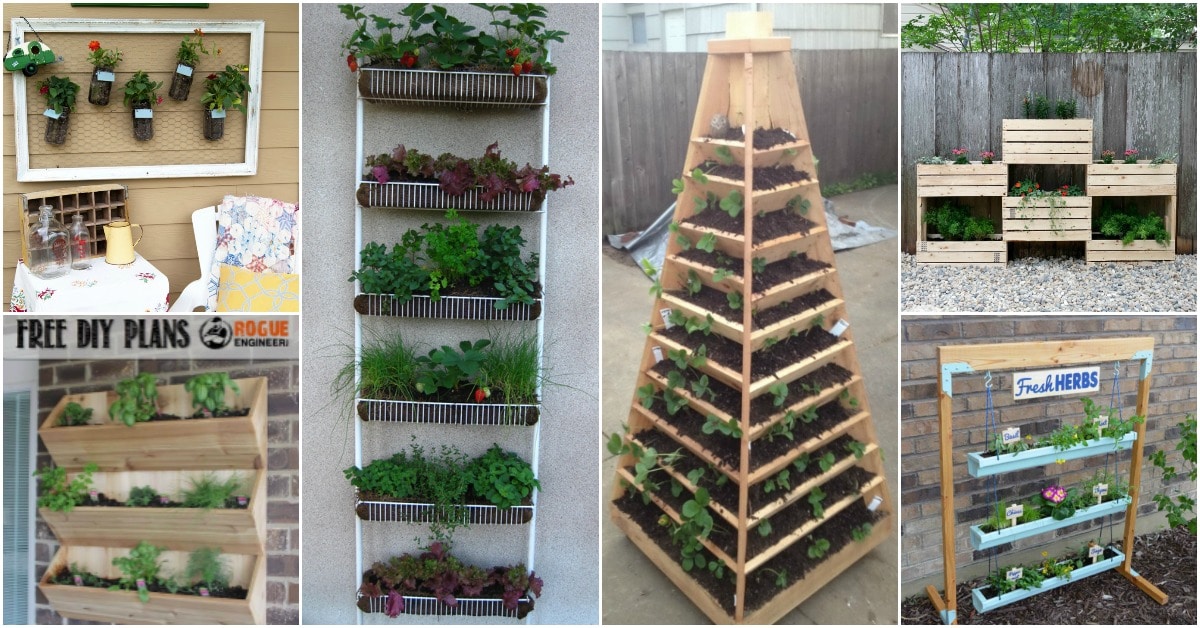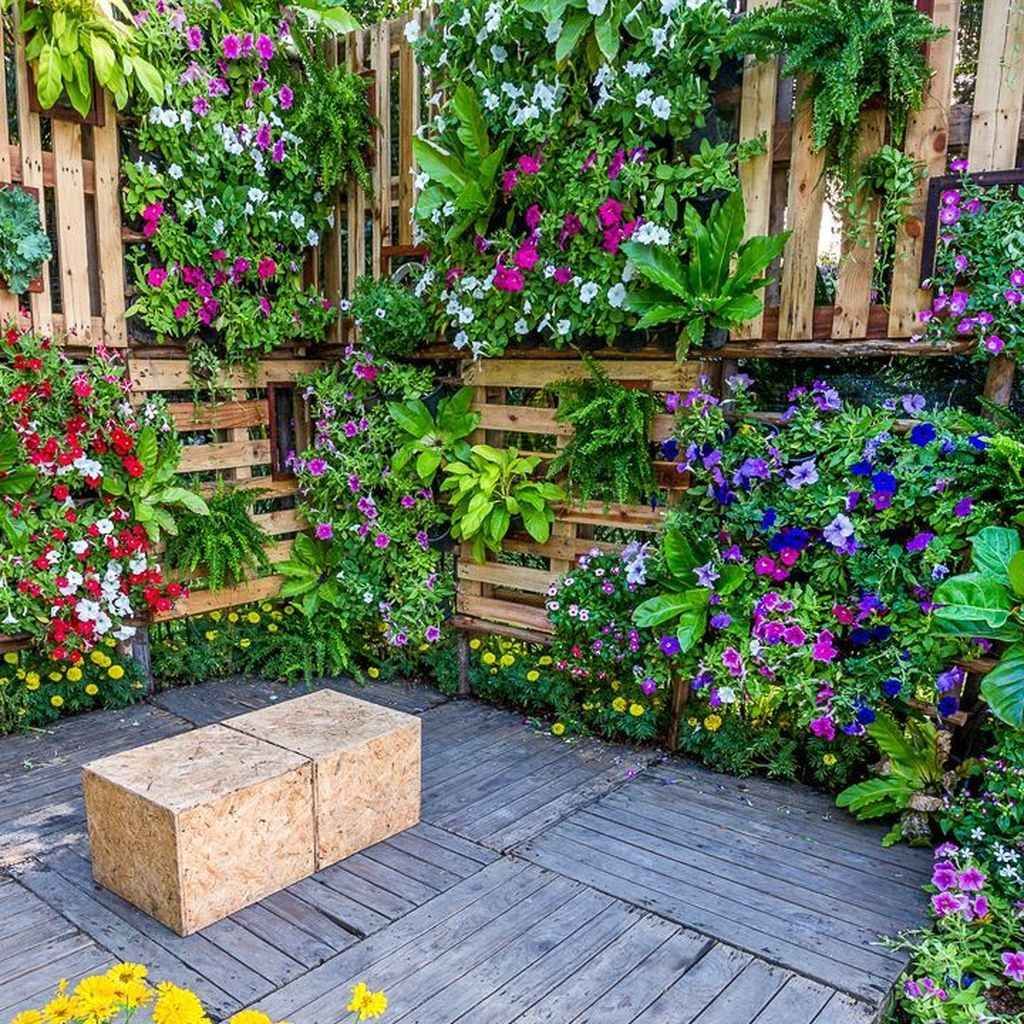DIY Vertical Garden: Imagine transforming a small balcony into a lush oasis, or adding vibrant greenery to a limited indoor space. With a vertical garden, you can create a thriving ecosystem that maximizes space and brings nature closer to you. This guide explores the fascinating world of vertical gardening, from planning and building to creative designs and sustainable practices.
Vertical gardening offers numerous benefits, including space-saving, aesthetic appeal, and environmental advantages. By utilizing vertical surfaces, you can cultivate a variety of plants, from herbs and flowers to vegetables and even small fruit trees. This innovative approach allows you to grow more in less space, making it perfect for urban dwellers, small gardens, or anyone looking to maximize their gardening potential.
Choosing Materials and Supplies

Building a vertical garden requires careful consideration of materials and supplies to ensure a sturdy, functional, and aesthetically pleasing structure. The choice of materials depends on your budget, the size and style of your garden, and your desired level of complexity. This section will delve into the essential components and tools needed to build a successful vertical garden.
Vertical Garden Structures
The structure of your vertical garden serves as the foundation for your plants. It should be strong enough to support the weight of the plants, soil, and water, and be weather-resistant if placed outdoors. Here are some common materials used for vertical garden structures:
- Wood: Wood is a popular choice for vertical gardens due to its natural beauty, versatility, and affordability. It can be easily cut and shaped to create various designs. However, wood requires regular maintenance to prevent rotting and insect infestations.
- Metal: Metal structures offer durability and longevity, making them suitable for outdoor gardens. They can be made from various materials like galvanized steel, aluminum, or recycled metal. However, metal can be more expensive and may require special tools for fabrication.
- Plastic: Plastic is a lightweight and inexpensive option for vertical gardens. It comes in various shapes and sizes and is often used for modular systems. However, plastic may not be as aesthetically pleasing as wood or metal and can degrade over time.
- Recycled Materials: Upcycling materials like pallets, crates, or old tires can add a unique and sustainable touch to your vertical garden. These materials are readily available and often free, making them a budget-friendly option. However, they may require more preparation and customization to create a functional garden.
Essential Tools and Supplies
The tools and supplies you’ll need for your vertical garden will vary depending on the materials and design you choose. However, some essential items include:
- Planters: These can be made from various materials, including plastic, metal, fabric, or recycled containers. Choose planters with drainage holes to prevent overwatering.
- Potting Mix: A good potting mix should be well-draining, airy, and rich in nutrients. Soil, coco coir, or hydroponic solutions are common options.
- Drainage Materials: These are used to prevent waterlogging in the planters. Examples include gravel, pebbles, or broken terracotta pots.
- Fasteners: These are used to secure the planters to the structure. Screws, bolts, zip ties, or wire are commonly used depending on the materials.
- Watering Can: A watering can with a narrow spout is ideal for watering plants in vertical gardens.
- Measuring Tape: For accurate measurements when building the structure.
- Saw: For cutting wood or other materials.
- Drill: For drilling holes in the structure and planters.
- Screwdriver: For attaching fasteners.
- Level: To ensure the structure is level.
- Gloves: To protect your hands while working.
Growing Media
The growing media you choose will impact the health and growth of your plants. It provides essential nutrients and supports the roots. Here’s a comparison of popular growing media options:
- Soil: Soil is a natural and readily available growing medium. It contains essential nutrients and microorganisms that benefit plant growth. However, soil can be heavy and prone to compaction, which can restrict root development.
- Coco Coir: Coco coir is a fiber derived from coconut husks. It’s lightweight, airy, and holds moisture well. It’s also naturally pest-resistant and pH-neutral. However, coco coir can be expensive and may require additional nutrients.
- Hydroponic Solutions: Hydroponics involves growing plants in nutrient-rich water solutions without soil. This method allows for precise control of nutrient levels and can lead to faster growth. However, it requires specialized equipment and knowledge.
Planting and Maintaining Your Vertical Garden
Planting and maintaining a vertical garden is an exciting journey, and it requires a little planning and effort to ensure your plants thrive.
Planting Techniques
Planting techniques are crucial for maximizing growth and aesthetics in your vertical garden. To ensure your plants have enough space to grow, consider the following:
- Spacing: When planting, allow sufficient space between plants for proper airflow and sunlight penetration. The specific spacing will depend on the type of plants you are growing.
- Depth: Make sure the planting pockets are deep enough to accommodate the root systems of your chosen plants.
- Soil: Use a high-quality potting mix that is well-draining to prevent root rot.
- Water Retention: Ensure the growing medium retains moisture but also allows for proper drainage.
Watering and Fertilizing
Regular watering and fertilizing are vital for the health and growth of your vertical garden.
- Watering: Water your vertical garden frequently, especially during hot weather. The frequency will depend on the climate and the type of plants you are growing.
- Fertilizing: Vertical gardens require regular fertilizing as the growing medium is limited. Use a balanced liquid fertilizer every two to four weeks, following the manufacturer’s instructions.
Common Problems and Solutions
Vertical gardens, like any other type of garden, can face certain challenges.
- Pests: Insects and other pests can be attracted to your vertical garden. Regularly inspect your plants for signs of infestation and take appropriate action.
- Diseases: Fungal diseases can be a problem in vertical gardens, especially if the plants are overcrowded or the growing medium is too wet. Ensure proper spacing and drainage.
- Root Rot: Overwatering can lead to root rot, a serious problem that can kill your plants. Ensure proper drainage and allow the growing medium to dry out slightly between waterings.
Creative Vertical Garden Designs: Diy Vertical Garden

Vertical gardens are not only visually stunning but also offer a sustainable and space-saving way to cultivate plants. They can transform any area, from a small balcony to a spacious patio, into a lush and vibrant green oasis.
Innovative Vertical Garden Designs, Diy vertical garden
Innovative vertical garden designs go beyond traditional wall-mounted structures. They incorporate unique shapes, materials, and planting methods to create eye-catching and functional green spaces. Here are some examples:
- Cascading Plants: Cascading plants, like trailing ivy or ferns, can be used to create a waterfall effect. They are often planted in hanging planters or tiered structures, creating a sense of movement and visual interest. The cascading effect adds a touch of elegance and sophistication to any vertical garden.
- Herb Gardens: Vertical herb gardens are a practical and aesthetically pleasing way to grow fresh herbs in limited spaces. These gardens can be designed as tiered shelves, stacked planters, or even repurposed items like old ladders or pallets. Herbs like basil, rosemary, and thyme thrive in vertical gardens, adding flavor and aroma to your outdoor space.
- Flower Walls: Flower walls are a vibrant and colorful addition to any space. They can be created using a variety of materials, such as recycled pallets, wire mesh, or even living walls. By planting a combination of flowering plants, you can create a stunning display of colors and textures.
Integrating Vertical Gardens into Different Spaces
Vertical gardens can be seamlessly integrated into various spaces, enhancing their aesthetics and functionality.
- Balconies: Vertical gardens are ideal for small balconies, maximizing space and creating a private green sanctuary. They can be used to create a sense of privacy, add visual interest, and even provide shade.
- Patios: Vertical gardens can transform a dull patio into a vibrant and inviting space. They can be used as a focal point, creating a backdrop for outdoor furniture or a dining area.
- Indoor Areas: Vertical gardens can bring a touch of nature indoors. They can be used to create a green wall in a living room, brighten up a hallway, or even add a touch of greenery to a home office.
Sustainable Materials and Techniques
Sustainable materials and techniques are essential for creating eco-friendly vertical gardens.
- Recycled Materials: Repurposing materials like old pallets, tires, or even plastic bottles can create unique and sustainable vertical garden structures. This not only reduces waste but also adds a touch of creativity to your design.
- Water-Saving Techniques: Vertical gardens can be designed to conserve water. This can be achieved through the use of drip irrigation systems, water-retaining materials, and drought-tolerant plants.
- Native Plants: Choosing native plants for your vertical garden is a sustainable and eco-friendly practice. Native plants are adapted to the local climate and require less water and maintenance.
Benefits and Challenges of DIY Vertical Gardens
Creating a DIY vertical garden offers a unique way to bring greenery into your space while reaping several benefits. From cost-effectiveness to environmental impact, these gardens provide a rewarding experience. However, it’s essential to consider the potential challenges involved and learn how to overcome them for a thriving vertical garden.
Benefits of DIY Vertical Gardens
Vertical gardens present numerous advantages, making them an appealing choice for home gardeners and urban dwellers alike.
- Cost-Effectiveness: DIY vertical gardens can be significantly more affordable than traditional gardens. You can utilize readily available materials like pallets, recycled plastic bottles, or even old tires to create your vertical structure, reducing the need for expensive gardening supplies.
- Space-Saving Solution: Vertical gardens are an excellent solution for maximizing limited space. They allow you to grow a variety of plants in a compact area, making them ideal for balconies, patios, or even small indoor spaces.
- Environmental Impact: Vertical gardens contribute to a greener environment by reducing soil erosion, promoting biodiversity, and improving air quality. The vertical structure allows for efficient water usage, minimizing water waste.
- Aesthetic Appeal: Vertical gardens add a touch of natural beauty to any space. The cascading greenery and vibrant flowers create a visually stunning and calming atmosphere.
Challenges of DIY Vertical Gardens
While vertical gardens offer many benefits, it’s important to acknowledge the challenges that come with their creation and maintenance.
- Maintenance: Vertical gardens require regular watering and fertilization, which can be more challenging than maintaining traditional gardens. The plants are closer together, requiring more frequent attention to ensure they receive adequate nutrients and moisture.
- Space Limitations: The limited space in a vertical garden can pose challenges for plant growth and root development. You need to choose plants that are suitable for vertical growth and have a shallow root system.
- Plant Selection: Choosing the right plants for your vertical garden is crucial. Consider the amount of sunlight, water requirements, and the size of the plants. It’s also essential to select plants that complement each other and create a visually appealing arrangement.
Tips for Overcoming Challenges
With a little planning and effort, you can overcome the challenges associated with DIY vertical gardens and enjoy the benefits they offer.
- Choose the Right Plants: Research and select plants that are well-suited for vertical growth and have a shallow root system. Some popular options include herbs, leafy greens, strawberries, and trailing vines.
- Install an Irrigation System: Implementing a drip irrigation system can simplify watering and ensure that all plants receive adequate moisture. You can use recycled plastic bottles or a commercially available drip irrigation kit.
- Regularly Monitor Your Plants: Inspect your plants regularly for signs of pests, diseases, or nutrient deficiencies. Early detection and treatment can prevent problems from escalating.
- Experiment with Different Designs: Don’t be afraid to experiment with different vertical garden designs to find what works best for you and your space. Consider using various materials and incorporating unique features.
Resources and Inspiration

Ready to dive into the world of DIY vertical gardening? There’s a wealth of information and inspiration out there to help you get started and create a thriving green wall. Let’s explore some helpful resources and get you inspired with successful examples.
Helpful Resources
Here are some great places to find information and support for your DIY vertical garden journey:
- Websites:
- The Spruce: Offers comprehensive guides on building and maintaining vertical gardens, covering various techniques and plant choices.
- Gardenista: Showcases stunning vertical garden designs and provides tips on creating your own.
- Vertical Garden Guru: Features detailed tutorials, product reviews, and inspiring project ideas.
- GrowVeg: Offers practical advice on growing vegetables in vertical spaces, including detailed planting plans.
- Books:
- “Vertical Gardening: The Complete Guide to Growing Up” by Christopher S. Burke: This book provides in-depth information on various vertical gardening techniques, plant selection, and design principles.
- “The Vertical Garden: How to Grow Plants Up Instead of Out” by Katherine Whiteside: This book offers a practical approach to vertical gardening, covering everything from choosing the right plants to building your own structures.
- “The Urban Homestead: Your Guide to Self-Sufficient Living in the City” by Kelly Coyne and Erik Knutzen: This book includes a chapter dedicated to vertical gardening, providing insights into growing food and herbs in limited spaces.
- Online Communities:
- Reddit: The “UrbanGardening” subreddit is a vibrant community where you can connect with fellow gardeners, share your projects, and ask questions.
- Facebook: Numerous Facebook groups dedicated to vertical gardening provide a platform for exchanging ideas, sharing photos, and getting support.
- Instagram: Use hashtags like #verticalgarden, #greenwall, and #diyverticalgarden to discover inspiring projects and connect with other enthusiasts.
Inspiring Vertical Gardens
To ignite your creativity, let’s explore some inspiring examples of DIY vertical gardens:
- A living wall in a small apartment: Imagine a lush green wall covering an entire wall in your apartment, bringing nature indoors and creating a serene atmosphere. This could be achieved using a modular system or a DIY frame filled with pockets for plants.
- A vertical herb garden on a balcony: A vertical herb garden on a balcony can provide fresh herbs for cooking while adding a touch of green to your outdoor space. Consider using a tiered planter or a wall-mounted system to maximize space.
- A vertical vegetable garden in a backyard: A vertical vegetable garden in a backyard can be a space-saving solution for growing a variety of vegetables, especially if you have limited ground space. Utilize trellises, hanging baskets, or DIY vertical planters to create a productive and visually appealing garden.
Share Your Vertical Garden Journey
We’d love to hear about your own DIY vertical garden projects! Share your experiences, successes, and challenges. Let’s inspire each other and create a vibrant community of vertical gardening enthusiasts.
Final Wrap-Up
Embarking on a DIY vertical garden project is a rewarding journey that allows you to connect with nature, create a beautiful space, and enjoy the fruits of your labor. From simple hanging planters to intricate living walls, the possibilities are endless. With a little creativity, patience, and the right resources, you can transform any area into a vibrant and sustainable vertical garden. So, get inspired, get your hands dirty, and start growing!
Creating a DIY vertical garden is a fantastic way to bring greenery into your home and add a touch of nature to your living space. It’s also a great project for those who enjoy crafting and want to get their hands dirty.
If you’re looking for more easy craft ideas for adults, check out this website for inspiration. Once you’ve found your perfect project, you can return to your DIY vertical garden and enjoy the process of bringing your vision to life.




